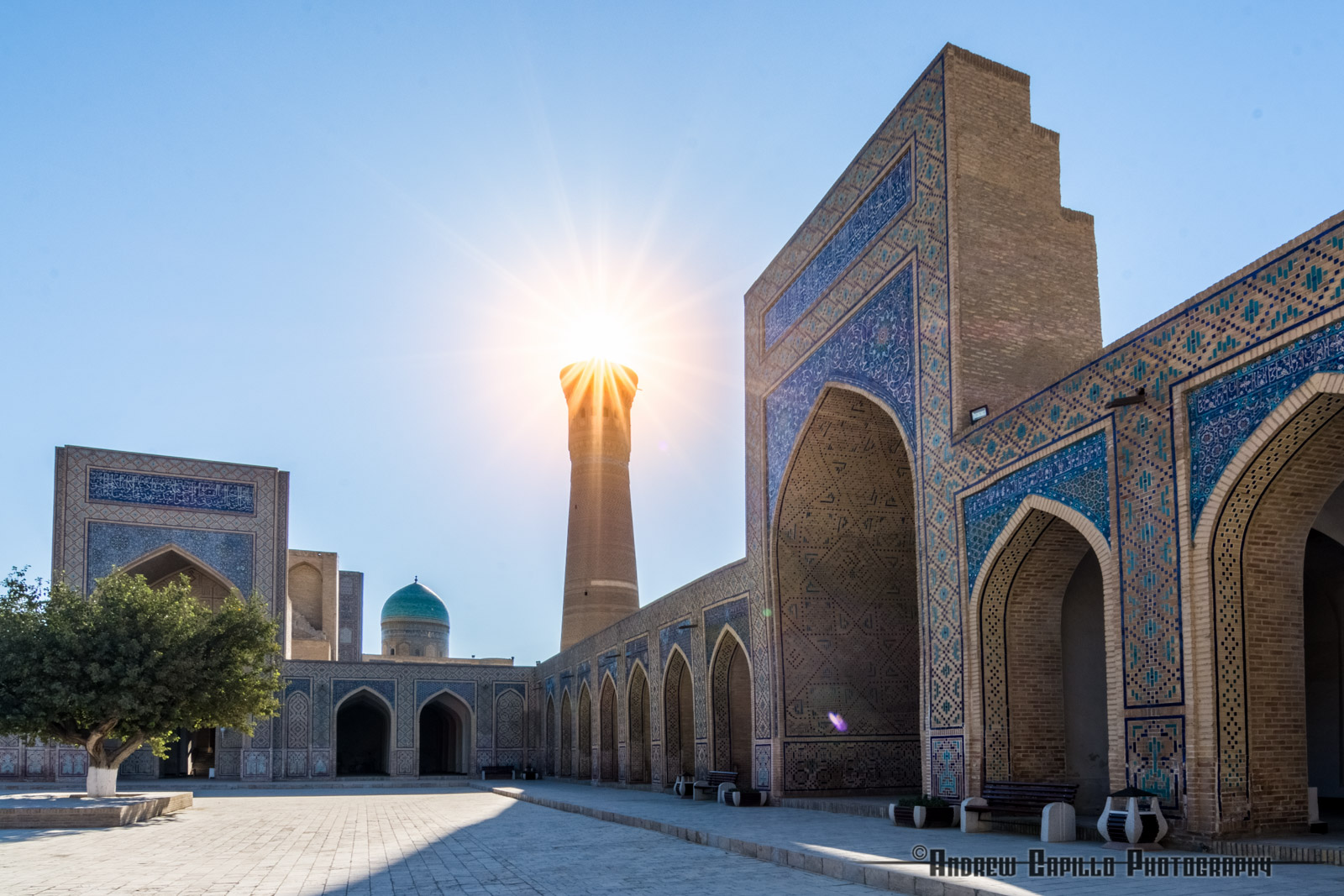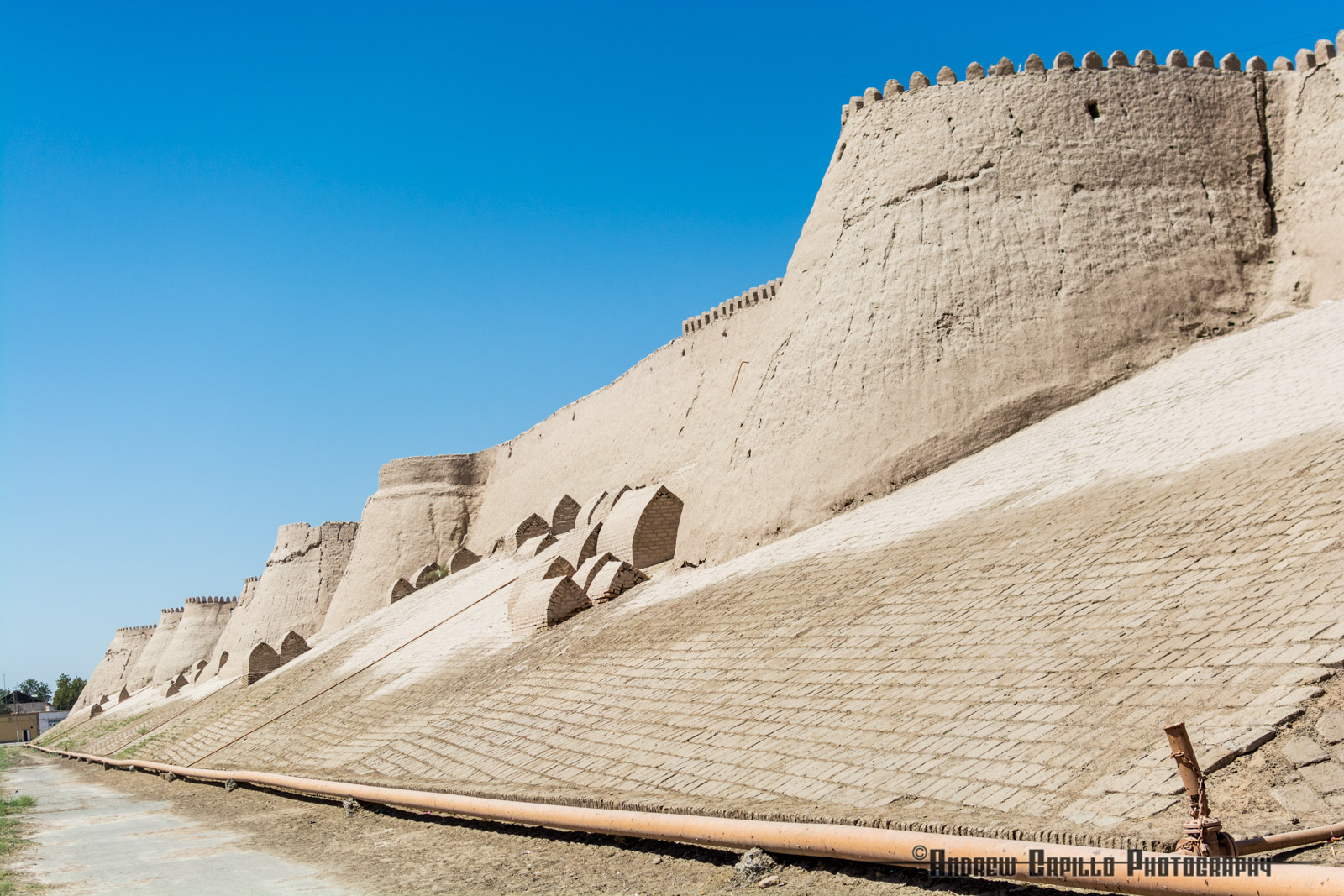In bygone day, the great silk way
Sowed temples and towers and gold.
Now brambles mass 'midst waving grass
On the once well-trodden road.
By the time of Amir Timur's death in 1405, his Timurid Empire had conquered its way out from his native Central Asia and present-day Uzbekistan to the coast of the Black Sea in the west and northern India in the east. Its multi-ethnic armies had rained blood upon the peoples of Persia and Mesopotamia and wiped out an estimated 5% of the planet's population in brutal campaigns of conquest. Timur's successes had been born of his capacity to successfully blend the mobility of the steppe nomads with Mongol tactics, Islamic law and Persian traditions. He is said to have possessed an unparalleled knack for military strategy and political intrigue. Although one of the most feared and ruthless conquerors of his time, he is regarded in Uzbekistan as the country's defining national hero. His ornate mausoleum, in which rests his black marble tomb, is one of the jewels of modern-day Samarkand, the old capital of Timur's sprawling empire.
According to legend, the inscription on his tombstone reads “When I rise from the dead, the world shall tremble." In June of 1941, a Soviet research expedition ignored the ominous warning and had the tomb opened. The inside allegedly revealed a second inscription, one even more dire than the first: “Whosoever disturbs my tomb will unleash an invader more terrible than I." Two days after the tomb was opened, Hitler launched Operation Barbarossa and invaded the Soviet Union with the largest invasion force of all time. Beginning to believe that the curse was real, Soviet leader Joseph Stalin ordered the remains of Timur reinterred with full Islamic rights in December of 1942. A little over a month later, the Nazis were defeated at the Battle of Stalingrad, the largest and bloodiest battle in history.
Timur's empire collapsed with his death and the internal power struggles that ensued among his followers. The resulting instability enabled the ethnically Turkic Uzbek tribes to descend from the northern steppes and conquer the whole of what is today Uzbekistan over the course of the next century. Although the most widely spoken language in the country today is Uzbek, a kaleidoscope of official and unofficial languages ranging from Russian to a variant of Persian to a nearly extinct cousin of Arabic attests to the many different settlers and conquerors this land has known.
Timur's death also coincided with a decline in trade and power in Central Asia. The dominance of the Great Silk Road, which for centuries had brought wealth to the region, was beginning to wane on account of newly-opened ocean trade routes. For generations, the old Uzbek cities of Samarkand, Khiva and Bukhara were the gateways between the great Eastern and Western civilizations. Caravans laden with silk from China, spices from India, silver from Iran, cloth from Byzantium and slaves from Turkey passed through here. Thanks to Central Asia's strategic location between East and West, it had become a key hub for not only traders, but also craftsmen, scientists and architects.
Great works of architecture were undertaken with the wealth these caravan routes brought. Palaces fortified by monumental fortress walls were constructed. Mosques, centers of worship, were erected alongside madrasas, centers of learning. And towering minarets rose up to punctuate the centers of these mercantile capitals. These great works of architecture betray a mostly Persian influence and owe their inspiration to the early Iranian settlers and a succession of civilizations that maintained a persevering reverence for Persian culture throughout the centuries.
With their winding stairwells and soaring platforms, minarets served both as a location from which to call the faithful to prayer five times a day and to keep a lookout for invaders. An additional role these towers played was as a place of execution. Bukhara's ancient 48-meter-high Kalyan minaret, girded with inscriptions and banded in 12th century geometric designs, was spared from ruin when Ghengis Khan laid waste to the city in the 13th century. Until as recently as the early twentieth century, criminals were executed by being thrown from its top, thus earning the minaret the nickname "The Tower of Death." Impressed by the looming minaret of Bukhara, the khan of nearby Khiva was determined to cement his own legacy with an even more ambitious undertaking. Khiva's turquoise-tiled Kalta-Minor ("Short Minaret") was destined to be the tallest minaret in all of Central Asia before construction stopped at just 26 meters. Legend says that the khan of Bukhara, having heard tell of his Khivan counterpart's audacious plans, sent word to his competitor's architect promising him wealth beyond imagining if he were to build an even taller minaret in Bukhara. When the khan of Khiva learned of this treachery, he sentenced his architect to be flung to his death from the top of his own minaret, thereby putting a halt to any further construction.
Praying five times a day is one of the pillars of Islam. Islam has held sway in Uzbekistan ever since the conquest of the region by Muslim Arabs in the 8th century CE. Another pillar of the Muslim faith involves investing a portion of one's income in the Islamic community. This usually entails donating to the poor, but for wealthy patrons a more enduring legacy mandated the commissioning of an opulent mosque complex, which would often include an attached madrasa or even a mausoleum for the benefactor and his kin. Uzbekistan's old cities are replete with examples of these lavish complexes. Past the yawning portals and beneath the glittering domes, a world of precise geometric patterns, floral designs and sweeping calligraphic scripts comes alive.
Abstract in form, these complex ornamentations are not an attempt to imitate nature, an act of creation that belongs only to God. Before the advent of Islam, Arab tribes were paganistic and had a strong belief in the worship and power of idols. When the Prophet Muhammad ordered his companions to destroy these idols wherever they found them, he sent a clear message denouncing those who would mimic the creation of his lord. It is for this reason that Islam strictly prohibits representation of living beings in art or architecture. Samarkand's Registan Square with its three imposing madrasas holds the rare exception. The façade of one of the structures, finished in 1636, features the mysterious and seemingly profane inclusion of two tigers with suns bearing the faces of humans on their backs in pursuit of two white gazelles. While scholars have argued over the significance of these figures, some have posited that they are fantastical and bizarre enough not to violate the prohibition on depicting living creatures.
Behind the doors of Uzbekistan's Persian-style architecture, open courtyards give way to a continuous play of design elements and indigo majolica patterns on the walls to create a pervading sense of peace and contemplation. Unity is one of the most crucial characteristics of Islamic architecture because it embodies the oneness of God and the idea that the whole universe is organized into a perfect divine system. Empty spaces are shunned and instead filled with a complex overlay of repetition and symmetry that helps to facilitate a sense of connectivity between different sections of a building and to generate an impression of unity and infinity. Tradition also plays a major role in the design of these structures. Hypostyle mosques with forest-like colonnaded halls evoke ancient Persian and Greek traditions, but can also trace their basic structure back to the house of the Prophet Muhammad in Medina.
The holiest part of any mosque is the mihrab, a niche in the wall that indicates the direction of Mecca, towards which all Muslim pray. Mecca is the city in which the Prophet Muhammad was born, and remains the home of the most important Islamic shrine, the Ka'aba. A third pillar of Islam commands every Muslim to attempt a pilgrimage to Mecca at least once in his or her lifetime. The final two ritual obligations of each adherent to the religion are the profession of faith and fasting during the holy month of Ramadan.
On every side of the mihrab, hypnotic tiled mosaics rise up the walls before retreating into arched honeycomb ornamentations known as muqarnas. Originating in Iran, these complex stacked stalactite formations establish a threshold between the mundane world of the worshipers and the divine world represented by the towering dome. The dome, and circles in general, are divine in nature on account of their infinite circular movement. The square-shaped floor of the mosque, and squares in general, are said to represent God's creation as they incorporate the four cardinal direction. Muqarnas, both rounded and square, are a point of transition between the cosmic and the creation. Stars, meanwhile, which spread in every direction, are said to signify the spread of Islam, and are ubiquitous in Islamic architecture. On a smaller scale, this same reverence for interlacing symbols and abstract design can be identified in calligraphic illustrations of the Qur'an.
Although Uzbekistan is now a Muslim country, it did not yield to Islam readily. In Bukhara in the 9th century, resistance to the new religion was so pervasive that the city had to be converted four times. In the city of Khiva, which was once one of the great slave trading hubs of Central Asia, denizens of the old city share the winding passages and limited space within the fortified walls with a sprawling above-ground necropolis. Oriented around the tomb of Pahlavan-Mahmud, a 14th century poet and philosopher, the arched brick tombs are partly a throw-back to the Zoroastrian religion that held sway here before the advent of Islam. The original Persian followers of Zoroaster considered the earth to be sacred and the burial of bodies a form of defilement. Encasing the bodies of the deceased in stone or brick protected the earth from pollution. The tombs now serve as yet another reminder of the impact of Persian culture on the region and of how, even after hundreds of years, the prevailing ideas and beliefs of those first settlers remained influential.
August 26, 2017
































































Andrew, love your blog and very impressed with such a detailed information! Liliana
ReplyDelete